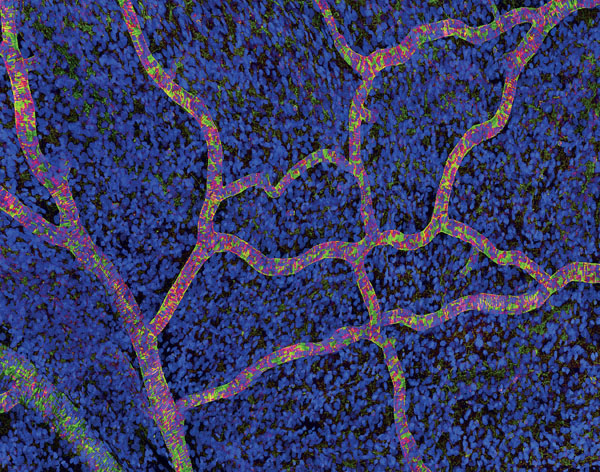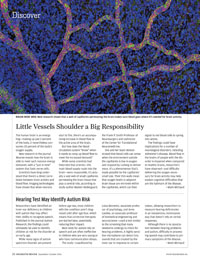In Review
 BRAIN-WIDE WEB: New research shows that a web of capillaries permeating the brain makes sure blood goes where it’s needed for brain activity. (Photo: Photo Researchers Inc.)
BRAIN-WIDE WEB: New research shows that a web of capillaries permeating the brain makes sure blood goes where it’s needed for brain activity. (Photo: Photo Researchers Inc.)The human brain is an energy hog—making up just 2 percent of the body, it nevertheless consumes 20 percent of the body’s oxygen supply.
New research in the journal Neuron reveals how the brain is able to meet such massive energy demands: with a “just in time” system that fuels nerve cells.
Scientists have long understood that there’s a direct correlation between brain activity and blood flow. Imaging technologies have shown that when neurons start to fire, there’s an accompanying increase in blood flow to the active area of the brain.
But how does the blood circulation system “know” when it needs to ramp up blood flow to meet the increased demand?
While some scientists had theorized that arteries—the main blood supply route into the brain—were responsible, it’s actually a vast web of small capillaries permeating the brain tissue that play a central role, according to study author Maiken Nedergaard, the Frank P. Smith Professor of Neurosurgery and codirector of the Center for Translational Neuromedicine.
She and her team demonstrated that blood cells can sense when the environment outside the capillaries is low in oxygen and respond by rushing to deliver more. It’s a phenomenon that’s made possible by the capillaries’ small size. Their thin walls mean that oxygen levels in adjacent brain tissue are mirrored within the capillaries, which can then signal to red blood cells to spring into action.
The findings could have implications for a number of neurological disorders, including Alzheimer’s disease. Blood flow in the brains of people with the disorder is impaired when compared to healthy brains, researchers have observed—and difficulty delivering the oxygen necessary for brain activity may help explain cognitive difficulties that are the hallmark of the disease.
—Mark Michaud
Hearing Test May Identify Autism Risk
Researchers have identified an inner-ear deficiency in children with autism that may affect their ability to recognize speech. Published in the journal Autism Research, the findings could ultimately be used to identify children at risk for the disorder at an early age.
While many signs of autism spectrum disorder are present before age two, most children with the condition aren’t diagnosed until after age four, which means that corrective therapies are started later, potentially reducing their impact.
Most tests for autism rely on speech and are often ineffective in children who are very young or who have communication delays.
The study—coauthored by Loisa Bennetto, associate professor of psychology, and Anne Luebke, an associate professor of biomedical engineering and neuroscience—used a test similar to the screening that many newborns undergo to check for hearing problems. A highly sensitive microphone can detect tiny sounds that are created by the inner ear in response to certain noises, allowing researchers to measure hearing deficiencies in an inexpensive, noninvasive way that doesn’t rely on verbal responses.
Although there is no association between hearing problems and autism, difficulty in processing speech may contribute to primary symptoms of the disease.
—Mark Michaud
Terahertz Waves May Allow a Window from Afar
Here’s the scene: a suspicious package is found in a public place. Police are called in, and they clear the area. Forced to work out of range of possible danger, and unable to peer inside the parcel, they fear the worst—and detonate the package.
But new research may, in the not-too-distant future, make possible the sensing of chemical, biological, and explosive materials from a safe distance.
Electromagnetic waves called terahertz waves—which fall between the infrared and microwave bands on the electromagnetic spectrum—can penetrate certain solid objects that are opaque to visible light, creating images of what’s hidden from view. And unlike traditional x-rays, the waves don’t harm human tissue.
But water molecules in the air absorb terahertz waves, weakening them as they travel. For the waves to be more useful, scientists have to find a way to make them more effective over greater distances.
And that’s what Rochester researchers have begun to do. Using an exotic laser beam called a ring-Airy beam, the team created a terahertz wave more than five times stronger than waves generated by conventional means.
The scientists were then able to detect a terahertz wave of that power at distances up to 100 feet.
Kang Liu, a PhD student in optics, led the project with Xi-Cheng Zhang, the M. Parker Givens Professor of Optics and the director of the Institute of Optics, in collaboration with a research group from Greece. The journal Optica has published their results.
The next step, says Liu, is to manipulate the laser beams to create even stronger terahertz beams over even greater distances. —Peter Iglinski
What Does Meaning Look Like in the Brain?
Think of the word “coffee.” For most people, it evokes a network of associations—color, taste, smell, and more. One small word is rich with “sensory, emotional, and social aspects,” says Rajeev Raizada, an assistant professor of brain and cognitive sciences.
And now scientists can see—and even predict—the patterns of brain activity elicited by words within the context of sentences.
Raizada is the senior author of a new study, published in the journal Cerebral Cortex, that used functional magnetic resonance imaging to decode and forecast the areas of the brain that are activated in response to particular sentences.
The team’s predictions are correct on average 70 percent of the time, says Andrew Anderson, a research fellow in Raizada’s lab. He led the study, which may contribute key advances to scientists’ understanding of how information is represented throughout the brain.
Previous research had focused almost exclusively on single words. Anderson and his collaborators moved the focus to predicting neural patterns for words within sentences. And they invented a new way to map the associations of words with patterns of brain activity.
Researchers say the results of the study may eventually lead to help for people with problems producing language, such as those who have experienced traumatic brain injuries or stroke.
—Monique Patenaude
Come on, Baby, (Re)Light My Fire
How can longtime couples keep the spark alive? Researchers say something called “responsiveness” may be key—and it comes into play through seemingly mundane interactions.
“Our research shows that partners who are responsive to each other outside the bedroom are able to maintain their sexual desire,” says Gurit Birnbaum, who completed postdoctoral work at Rochester and is now a psychology professor at the Interdisciplinary Center Herzliya in Israel. The study, coauthored by Harry Reis, professor of psychology, was published in the Journal of Personality and Social Psychology.
The research began as an inquiry into what psychologists call the “intimacy-desire paradox.”
People tend to strive for intimacy and familiarity in their relationships, researchers note, but such close bonds don’t seem to foster desire. Previous studies hadn’t established whether emotional intimacy promotes or undermines sexual desire—and now Reis and Birnbaum’s research suggests that, at least in certain circumstances, there may not be a paradox at all.
Intimacy alone doesn’t fuel or hamper desire, they found. Instead, what matters is intimacy’s meaning in the larger context of a partnership.
Responsive couples are willing to invest resources in their relationships and show understanding at a deep level. Responsiveness, itself a kind of intimacy, is most likely to encourage desire because it conveys the impression that a partner is worth pursuing—an effect particularly reflected in women’s perceptions of themselves and others.
“Sexual desire thrives on increasing intimacy, and being responsive is one of the best ways to instill this elusive sensation over time,” Birnbaum says.
—Monique Patenaude

